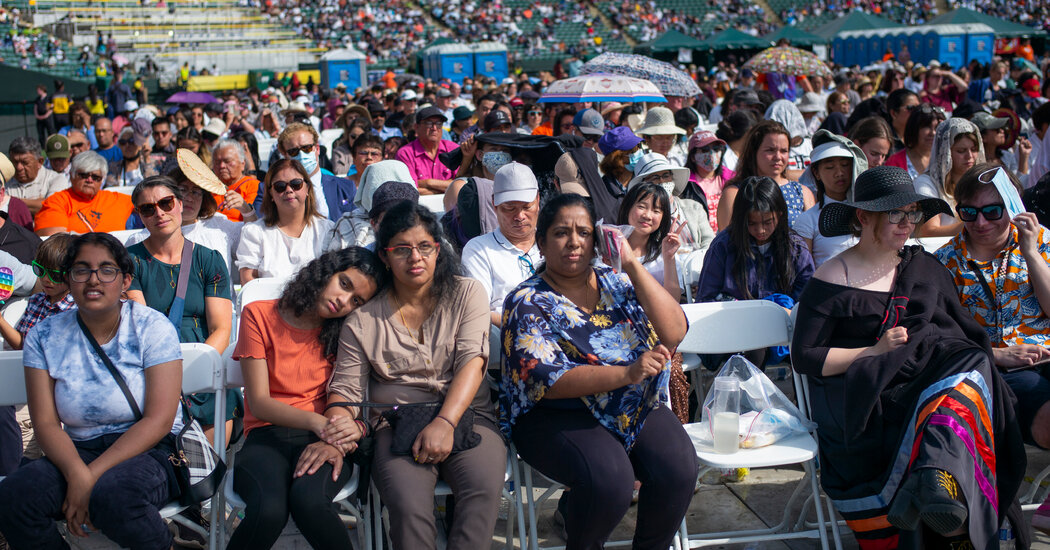
EDMONTON, Alberta — The centerpiece of Pope Francis’s journey to Canada this week was his historic message of apology on Monday to the country’s Indigenous people for the Catholic Church’s role in the notorious residential school system that tried to erase their culture, and in which thousands of children were abused and died.
But as Francis continued his travels across the country — from Alberta, where he delivered the apology, to Quebec and Nunavut in the Arctic — his stops also told the story of the church’s unusually stable position in Canada.
Large numbers of immigrants from South Sudan, India, the Philippines, South Korea and elsewhere were prominent in the crowd at Commonwealth Stadium in Edmonton, Alberta, on Tuesday, just as they are in the country’s Catholic churches, a product of Canada’s generous immigration policy, which embraces immigrants and formally promotes multiculturalism.
While the Roman Catholic church is in severe decline in many Western countries, it remains the largest denomination in predominately Christian Canada, accounting for about 38 percent of people who identify with a particular faith. And outside Quebec, a French speaking province it once dominated, the church’s decline has been modest. In 1951, 41 percent of Canadians said they were Catholics.
The reason for the church’s stability, most analysts agree, is Canada’s relatively open immigration policies, which mean that immigrants make up a much larger share of Canada’s population than they do in the United States and other Western countries where Catholicism is waning.
A study by Canada’s census agency released late last year found that Catholicism represents the largest faith among newcomers to the country. More important, the survey also determined that most of those immigrants are active church participants.
“Immigrants now make up a large proportion of the most faithful participants at Sunday mass,” said Gordon Davies, a former priest in the archdiocese of Toronto for 20 years who taught at the Toronto School of Theology and was a dean of Canada’s largest seminary, Saint Augustine. “The question is whether or not the second generation will continue to be as active in their faith.”
Mr. Davies and others say that the support immigrants have provided the Catholic Church in much of Canada doesn’t mean the church isn’t vulnerable to the declines that have diminished the country’s long established Protestant churches.
“There is in general some kind of disillusionment with the churches,” said Dr. Michel Andraos, the dean of the Faculty of Theology at Saint Paul University in Ottawa.
The Abuse of Indigenous Children in Canada and the U.S.
But Canada’s immigrants have strengthened the church and given it vitality, Mr. Davies said, something he has witnessed firsthand at his own Toronto church. Today he estimates that about 40 percent of his fellow parishioners are from the Philippines and a large number of others are Tamils from Sri Lanka.
“It’s like going to Manila every weekend,” he said. “It’s a cultural experience which is actually very healthy for me.”
Dr. Andraos is himself a Catholic immigrant to Canada, his family having fled the civil war in Lebanon during the 1990s.
For many immigrants, he said, churches are as much a settlement service and cultural community as they are a spiritual centers. And once they have established themselves in Canada, he said, they often drift away from the church.
“My whole family immigrated and all of them very active church goers the first 10 years or so,” Dr. Andraos said. “Now no one in my family goes to church.”
Regardless of what the future holds, Dr. Andraos said the arrival of Catholic immigrants has had a profound effect on the church in the largely French speaking province of Quebec where Pope Francis arrived on Wednesday.
For much of its history, the Roman Catholic church dominated not just the spiritual life of the province but also education and health care and had a significant influence over business and politics. But in what came to be known as the quiet revolution, a Liberal government formed in 1960 and began taking back those powers starting with schools. Secularism became a guiding principle.
The effects of that continue today and include a recently passed law that bans the wearing of religious symbols, including Christian ones, by public sector employees, including teachers. Over the decades churches and church institutions have closed and been converted to other uses.
Secularism has replaced Catholicism in Quebec more than in any other province, and Dr. Andraos said that the Catholic church is almost now extinct in rural parts of the province. Yet, even in Quebec there has been a resurgence of large, vibrant congregations in Montreal made up of immigrants, often from Africa.
When he meets with parishioners at those churches, he said, he finds that there is sometimes a disconnect between them and long established members of the church in Canada.
That is particularly true on the issue that brought Francis to Canada: reconciliation with Indigenous people for the harms they suffered at church run residential schools. After failing to largely make good on a class action settlement with former students, the church is now attempting to raise 30 million Canadian dollars from its members.
“They have no clue why they should contribute to that,” Dr. Andraos said, referring to recent Catholic immigrants. “What have they done?”
But he has found that once the suffering of the students is laid out, most of them understand the obligation.
Similarly, Mr. Davies said he has found members of many immigrant congregations to be far more conservative than many church members born in Canada.
“They have nothing to do with stirrings in the Canadian Catholic Church to accept same-sex marriage and to bring women in,” he said. “That’s not part of their sense of Catholicism and they’d be dead set against it.”
Immigration has also filled another need of the church in Canada. Dr. Andraos said few, if any, Canadians were willing to become priests and that situation is unlikely to change unless priests were allowed to marry. Not one of the 110 theological students at his university currently intends to become a priest.
So most of Canada’s priests now come from aboard. Father Susai Jesu who hosted the pope at his Indigenous parish in Edmonton this week was born in India.
Vibrant, immigrant-based congregations have so far allowed some archdioceses, including Toronto’s, to not close churches, though Mr. Davies said closures are needed to consolidate financial and clerical resources, which are limited because many immigrants lack the wealth necessary to sustain large Canadian churches.
The one place where the church is currently disposing of churches and other buildings on a large scale is Newfoundland and Labrador. The archdiocese there filed for bankruptcy after a court ruled that it must compensate about 100 people who were sexually abused at an orphanage between the 1940s and the 1960s.
The boost provided by immigrants, Mr. Davies said, helped stop the church from disappearing. But it will not, in the long run, keep it from shrinking to a more sustainable version of itself.
“It might not be in my lifetime,” he said. “But I might see the beginnings of that restructuring and that healthy regrowth in my lifetime.”
As the crowd spilled out of Commonwealth Stadium in Edmonton on Tuesday, a sea of diverse faces appeared. Within the crush of people searching for buses or lining up for trains was Israel Izzo Odongi, who moved to Canada 23 years ago from South Sudan and who made the trip from Calgary, Alberta to see the pope with other members of a South Sudanese congregation.
Nearby was Jesu Bala, who moved to Edmonton, Alberta, from Chennai, India, 13 years ago. Mr. Bala, who was with four family members, said that they were part of a South Asian congregation.
Even when the pope made his way to Lac Ste. Anne, Alberta, a pilgrimage site founded in the 19th century for Indigenous Catholics that lies about an hour north of Edmonton, large numbers of immigrants were there.
Reina Donaire, 36, from Edmonton, stood at the lip of the lake, only feet from where Francis would minutes later bless the water, with four other friends from the Philippines.
“Mostly the churchgoing people are Filipino,” she said, adding that she and other immigrants, including from Africa, provided a lift to the Canadian church. “We’re strong Catholics and maybe in that way we help them.”
Jason Horowitz contributed reporting from Lac Ste. Anne, Alberta.




